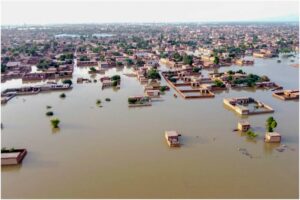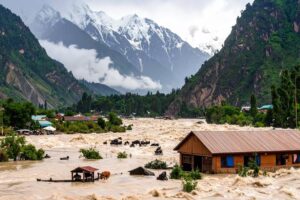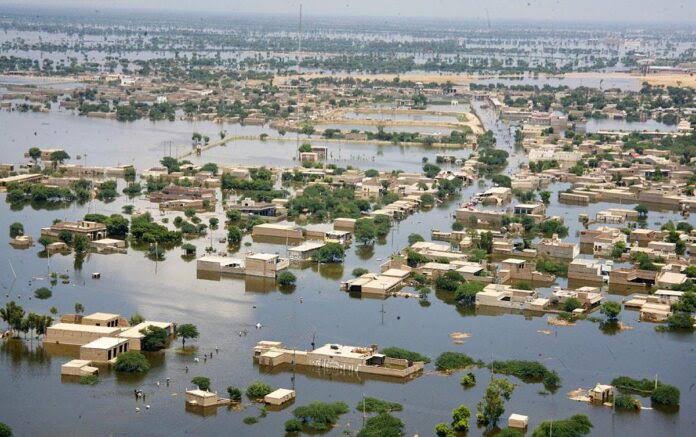
Pakistan Faces Worst Monsoon Floods in Years: Death Toll Crosses 160 in 24 Hours 14_8_2025

Severe monsoon rains and flash floods have wreaked havoc in northwestern Pakistan, killing over 160 people in a single day. Here’s the latest update on the tragedy, rescue efforts, and the challenges ahead.
Introduction
Pakistan is facing one of the most destructive monsoon disasters it has experienced in recent years. In just 24 hours, relentless rains and flash floods have claimed more than 160 lives, with the total death toll of this monsoon season now crossing 300. The hardest-hit areas lie in the northwestern regions, where entire villages have been submerged, and rescue efforts are battling extreme weather and treacherous terrain.
The Current Situation

Since early August, torrential monsoon rains have battered Pakistan. But the past 24 hours have been catastrophic — Buner district alone reported over 150 fatalities, and many more are missing. The Pakistan Meteorological Department has issued fresh warnings of continued heavy downpours, particularly in Khyber Pakhtunkhwa, Gilgit-Baltistan, and parts of Punjab.
Authorities have described this monsoon as “unusually intense,” with rainfall levels far exceeding the seasonal average. Rivers have burst their banks, triggering landslides and cutting off major road networks. Flash floods have swept away homes, livestock, and farmlands, leaving thousands homeless.
A Humanitarian Crisis Unfolds
For the people in flood-hit districts, survival has become a daily struggle. Families have been forced to seek shelter in makeshift camps, schools, and mosques. The drinking water is dirty, which is causing worries about diseases like cholera and typhoid.Food shortages are worsening, and many residents are relying entirely on aid from relief organizations.
“I have lost my home and my crops,” says Muhammad Ashraf, a farmer from Shangla district. “I don’t know how my family will survive the coming weeks.” His story echoes that of thousands across the region — lives uprooted in an instant, with uncertainty clouding the future.
Tragedy in the Skies: Rescue Helicopter Crash
The situation became even worse when a military MI-17 helicopter, sent for rescue work in Khyber Pakhtunkhwa, crashed during its mission, killing all five crew members on board.Officials believe bad weather played a major role in the accident. The incident has not only shaken the morale of rescue teams but also highlighted the extreme risks involved in relief efforts under such hazardous conditions.
National and International Response
The Pakistani government has mobilized the army, navy, and air force for search and rescue operations. Boats, helicopters, and heavy machinery are being used to evacuate stranded people and deliver supplies. The National Disaster Management Authority (NDMA) has set up emergency relief centers, while NGOs are distributing food, blankets, and medical aid.
International organizations, including the United Nations and the Red Crescent, have expressed solidarity and offered assistance. Neighbouring countries are also sending aid packages, recognizing the severity of the disaster.
Why This Flood is So Severe
Meteorologists attribute the intensity of this year’s monsoon to shifting weather patterns and climate change. Rising temperatures have increased moisture levels in the atmosphere, leading to heavier and more frequent downpours. Poor urban planning, deforestation, and encroachment on riverbanks have worsened the impact by reducing natural water drainage capacity.
Experts warn that without significant investment in flood defenses, Pakistan will continue to face catastrophic flooding in future monsoon seasons.
Challenges on the Ground
Rescue workers are dealing with multiple obstacles:
• Blocked roads. caused by landslides and flooding have cut off access to many areas.
• Communication Blackouts: Power outages and damaged telecom infrastructure are hindering coordination.
• Shortage of Resources: There are not enough boats, helicopters, or medical teams to meet the scale of the disaster.
• Health Risks: Stagnant water is becoming a breeding ground for mosquitoes, raising fears of dengue outbreaks.
What Needs to Be Done
Experts recommend immediate and long-term steps:
1. Strengthen Disaster Preparedness: Equip local communities with early warning systems.
2. Invest in Infrastructure: Build stronger embankments, improve drainage, and restore wetlands.
3. Climate Resilience: Adopt sustainable land use policies and promote tree planting to reduce runoff.
4. Public Awareness: Educate citizens about flood safety measures and evacuation plans.
The Road Ahead
While rescue operations continue, the human and economic costs of this disaster will be felt for months, if not years. Rebuilding homes, restoring farmland, and rehabilitating affected families will require significant resources and political will. This tragedy also serves as a stark reminder of Pakistan’s vulnerability to climate-induced disasters.
Conclusion
The 2025 monsoon floods in Pakistan will be remembered not just for the staggering death toll, but for the resilience and courage shown by those affected. From rescue workers risking their lives in treacherous conditions to ordinary citizens helping neighbours in need, the disaster has revealed both the fragility and the strength of the human spirit.
The coming weeks will test Pakistan’s capacity to respond and recover. But with timely action, community support, and global cooperation, the nation can emerge stronger and better prepared for the challenges ahead.


y2rg0x
rzlc23
An incredibly well-written article.